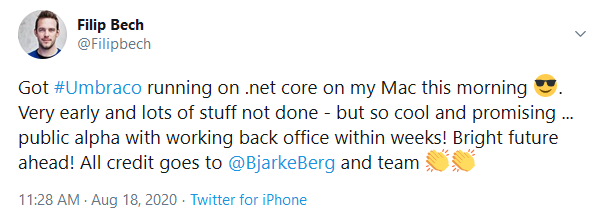After 9 months of intense development, the alpha release of Umbraco on .Net Core is a big milestone. It has been a great community effort spearheaded by the Unicore Team. We are getting close to a release of the alpha and will keep you posted on the blog as soon as we have something ready to show.
Upcoming Release: Umbraco 8.7 (Release Candidate is out now!)
Last week the Release Candidate for Umbraco 8.7 was made available. We’ve already received a ton of great feedback which really helps in making a better final release - so big thanks to everyone who helped testing. You can read more in the Release Candidate blog post.
Based on internal testing and community feedback from the RC we’ve decided to push the release date a bit. This gives us time to address the feedback and add some extra release polish. Umbraco 8.7 is currently targeted for release on September 10th, 2020.
Upcoming release: Umbraco Uno UX overhaul
The editing experience has been completely overhauled to make full use of the goodies in Umbraco 8.7. This means Umbraco Uno will be using the Block List editor instead of Nested Content providing an even better backoffice experience. We can’t wait to show you just how much you can do with the Block List editor.
Target release date: Along with the release of Umbraco 8.7
What’s new in Umbraco Cloud
Last Tuesday, August 25th, we released an update for Umbraco Heartcore´s GraphQL caching layer giving you even faster content retrieval. We’re now using entity tags(ETags) to (in)validate the cache on a per request basis. This means we'll handle the most common caching needs for you, so there is less for you to worry about. If any changes have been made to requested items, we´ll know and get them from our datastore; otherwise, it’ll be served directly from Cloudflare’s cache.
GraphQL functionality for Umbraco Heartcore was launched recently, and you can read all the details in the release blog post.
Updates to the Roadmap
With all the wonderful release activity over the last couple of weeks a lot, and several upcoming releases, there has been a lot of movement on the Product roadmap. I’ll give you a little tour on what has changed and what has been added.
New in “Now”
CMS authentication improvements
We’ve been working on improving the user authentication workflow on Umbraco Cloud (separate item on the roadmap). Part of the changes also requires improvements to the CMS, thus we've added a new item on the roadmap. This benefits all Umbraco developers, whether you’re on Umbraco Cloud or not, and therefore we’ve added the CMS specific improvements as a new item.
You’ll have far more control when implementing custom OAuth login with great features such as custom views on a custom provider basis, better error handling and support for external redirects and more. You can read all the details WIP PR on Github, and we’ll make sure to keep you updated in future Product Updates.
New in “Next”
Version Cleanup
Umbraco stores all previous versions of content in the database. While it is great to have the complete history and be able to rollback to all previous versions, there are scenarios where having more control over versions can be beneficial. With this feature, you’ll be able to control how many versions are saved and how far back in time you want to have the ability to rollback. The plan is to make this configurable, in code, on a per-document type basis. The benefit of cleaning up versions is database size (fewer versions == smaller footprint) and will help performance, especially on sites with a lot of activity/content.
This functionality is currently available via the UnVersion package, maintained by Umbraco MVP Søren Kottal, and we’re in contact to align functionality. Søren currently has two twitter polls up on how UnVersion is being used:
Poll on using document type alias filter
Poll on using rootXpath filter
So if you use, or have used the package, feedback would be much appreciated.
Dashboard for Umbraco Deploy
We’re still hard at work on Umbraco Deploy on Prem. Part of this is to give more control and information in the backoffice such as being able to import changes (UDA files) with a single click of a button instead of having to create marker files in the filesystem. We’ll share more on this in future Product Updates.
GraphQL Filtering
We’ve started working on advanced filtering for GraphQL queries in Umbraco Heartcore. This will make it possible for you to do granular filtering and let the GraphQL API handle parsing the logic.





